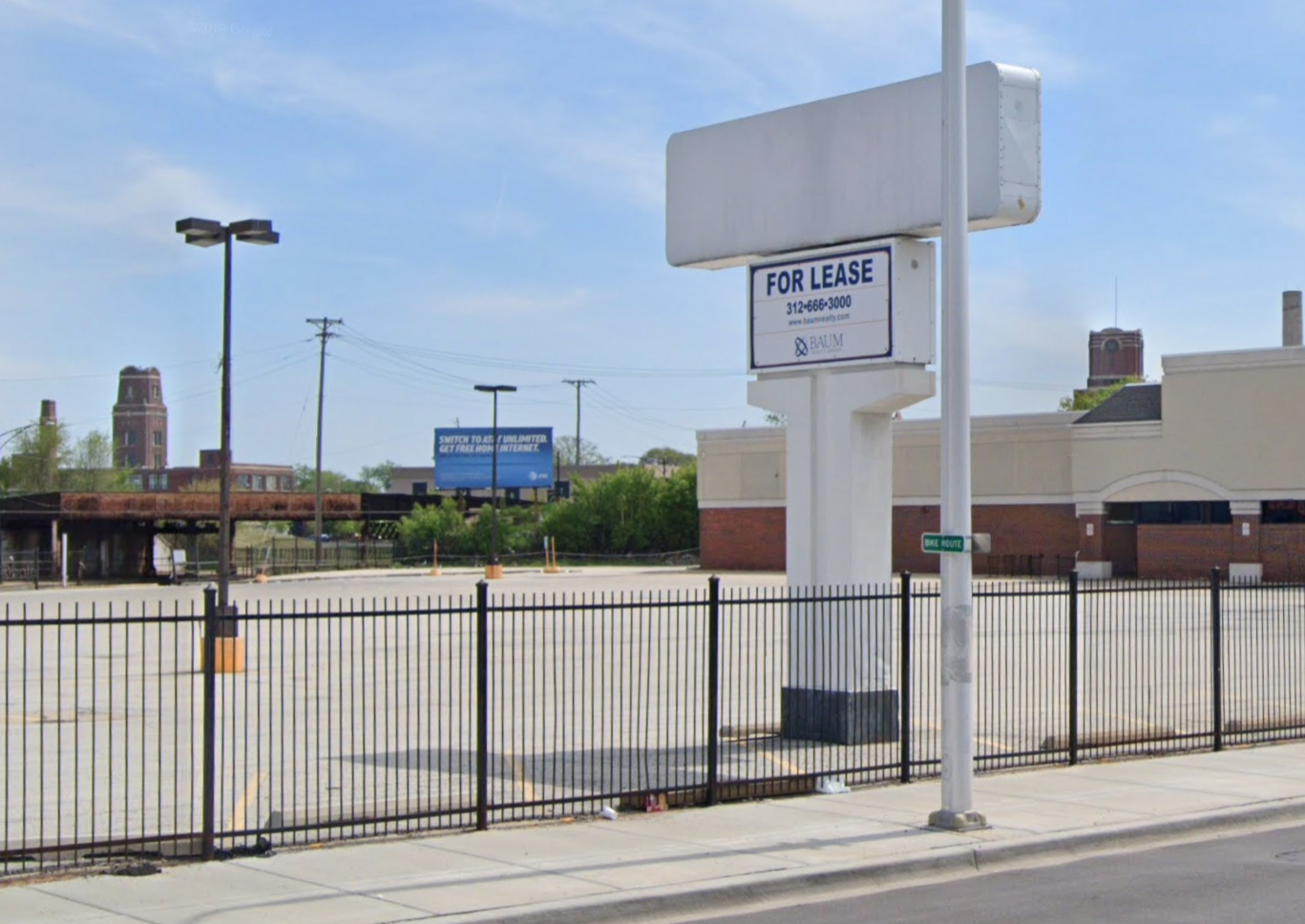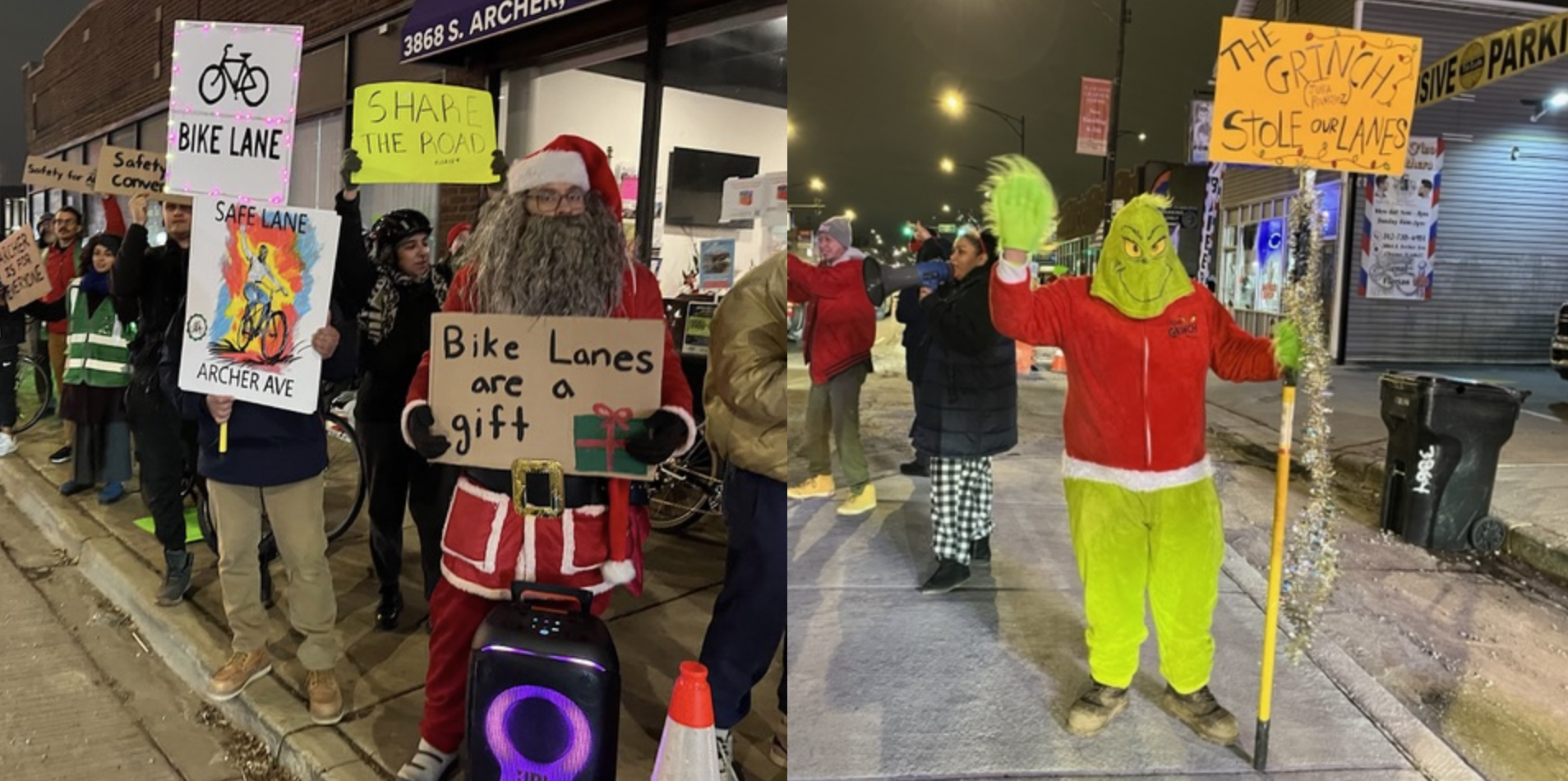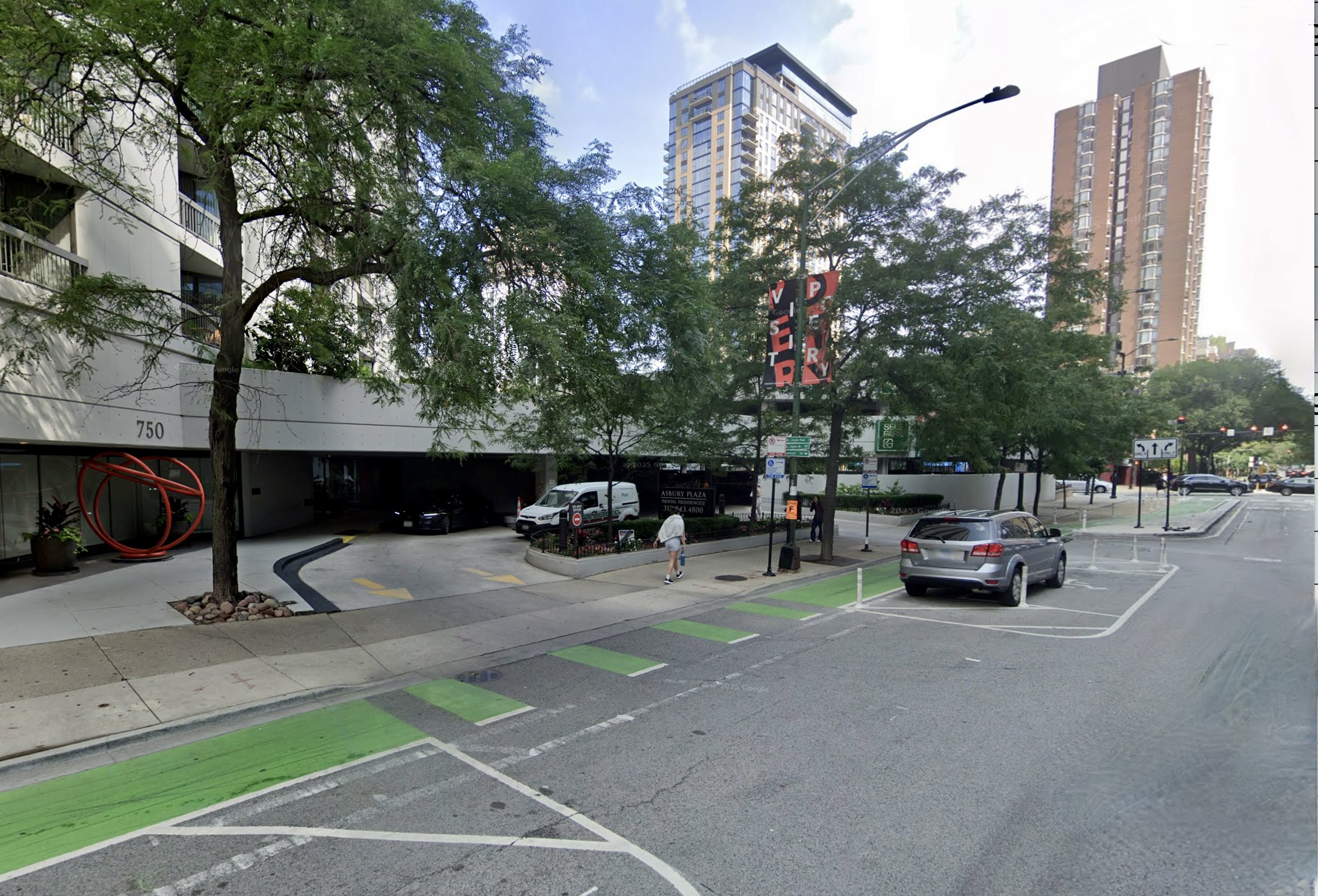A version of this piece also ran on Steven Vance's development website Chicago Cityscape.
Prominent Chicago real estate developer, Sterling Bay has proposed a new Metra station in the West Loop at 1300 W. Carrol St., which is across the street from the developer's headquarters and closer to several of Sterling Bay's other properties than the Metra terminals at the Ogilvie Transportation Center and Union Station. Many of the workers at those buildings take ride-hail or shuttle buses operated by their employer or the property manager to their offices. Therefore, the new station would help reduce vehicle miles traveled, so it's a great idea.
There should also be new infill stations in other Chicago neighborhoods to take advantage of the system's regional reach, and to fill in gaps in the CTA’s ‘L’ and slow bus networks. Humboldt Park one such area that could benefit from a new Metra stop. I took a look at two potential locations:
- Chicago/Kedzie, in the Humboldt Park community area, and near the East Garfield Park community area
- Division/Grand/Central Park, four blocks west of the park
Both potential locations are where three lines -- Milwaukee District-North (MD-N), Milwaukee District-West (MD-W), and North Central Service (NCS) -- share tracks before they diverge near the western end of the Bloomingdale Trail.
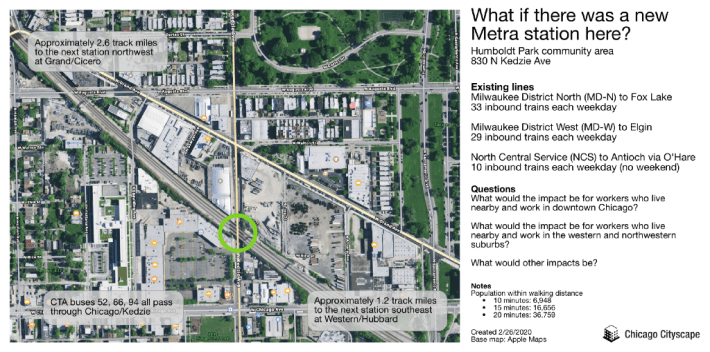
Benefits of building a new Metra station
There are two main benefits of building any new Metra station:
- People who live near the new station gain new access to jobs and amenities elsewhere along the line. For example, someone who lives at the Salvation Army Freedom Center would be able to more conveniently access a job in Bensenville or O’Hare Airport, where there are many logistics businesses.
- People who live elsewhere along the line gain new access to jobs and amenities near the new station. It’s the same benefit as the first, but with the people and work flowing in the opposite direction.
More stations are key to better service
Building infill stations is paramount for creating an effective RER system. RER means Regional Express Rail (see Note 1 at the end of this article for an explanation.) It’s a name borrowed from the Paris region that turns commuter rail systems that serve morning commutes in one direction and afternoon commutes in the opposite direction into a regional rail system that serves people going in multiple directions. The difference between Metra and RER is designing service for all riders.
Metra is geared towards serving people who work weekdays in the Chicago Loop, particularly suburbanites. Regional rail, on the other hand, is designed to serve those riders and everyone else: people with jobs in the suburbs, folks running errands, and people who need to get somewhere at a convenient time between rush hours. To be able to serve those people, you need more stations. Regional rail also requires more frequent service, but this post is specifically about infill stations.
Connecting Humboldt Park to the West Loop
There’s another benefit that would be specific to building a new Metra station in Humboldt Park. A majority of the region’s jobs are in downtown Chicago, and this new stop would offer Humboldt Park and East Garfield Park residents a fast ride to downtown. In fact, two or all three of the lines would stop at the proposed new station in the West Loop, depending on its final location.
Envision this: Humboldt Park and the West Loop would be connected by a fast, single, two-stop trip. Humboldt Park and downtown Chicago would be connected by a fast, single, three-stop trip.
When the city of Chicago and the CTA opened a new Green/Pink Line station at Morgan a few years ago, plenty of new trip opportunities opened up, following the two main benefits listed above. Living in one place and working in another place, if they’re both along the Green or Pink Lines, suddenly became more feasible and convenient. For example, you can live in Austin and easily get to work in Fulton Market. Or you can reside at one of the co-living residences in the West Loop and conveniently get school in the South Loop.
The city is currently constructing a new Green Line station at Damen/Lake, but I’ve argued that officials haven’t created a transit-supportive land use plan.
1. Chicago/Kedzie hypothetical station
Let's look at what’s nearby the hypothetical new Metra station on Kedzie Avenue just north of Chicago Avenue. Imagine the station being at the center of four land use quadrants. As it stands, two of these quadrants contain light industrial uses, one has a busy anchor strip mall that with clothing stores, two grocery stores, a bank, and several restaurants, and the fourth has older buildings with commercial uses. That’s just on the first block.
Walking a block further, and you'll start passing by residential uses. In fact, according to 2015 population data, about 16,656 people live within a 10 minute walk of the hypothetical station. (Get a Transportation Snapshot at Chicago Cityscape and see details on how that number is derived.)
Suddenly, with trains stopping a couple dozen times a day, there’s an incentive for the strip mall owner to densify the land, potentially adding housing and more retail. Across from the strip mall the Chicago Park District is expanding and improving Kells Park.
The new station could be paid for with money from the Chicago/Central Park TIF district. Tax increment financing money is partially funding the new Peterson and Auburn Gresham Metra stations.
2. Division/Grand/Central Park hypothetical station
A new station at Division/Grand/Central Park would serve the same three Metra lines as the Chicago/Kedzie hypothetical station. Fewer people live within a 10 minute walk of this site than Chicago/Kedzie (11,344 versus 16,656) but the advantage of this location over the first is the opportunity for equitable transit-oriented development. This location is surrounded by vacant land and low-density commercial uses that could be developed to add housing.
At this site, a CVS drug store with a huge parking lot was shuttered nearly four years ago, and the company still owns the property, but the building has stood empty since then. Metra could purchase this land for its station platforms, ramps, and waiting rooms, and there would still be plenty of room on the property for hundreds of new affordable or mixed-income apartment and townhouses.
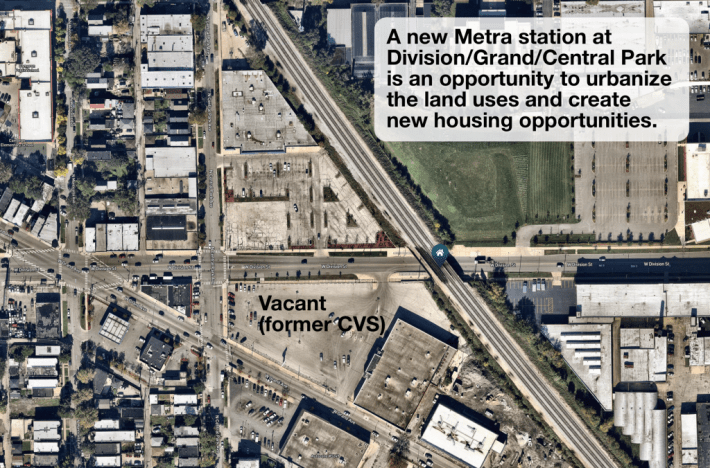
Great idea, now what?
Sterling Bay has considerable influence, and its own funding sources that could potentially contribute land, planning studies, or direct contributions, which could help get the station built. Beyond the Peterson and Auburn Gresham stations, I’m unaware of any planning for new Metra stations within the city. And since Chicago mayor Lori Lightfoot controls the CTA but not Metra, and has opposed the South Cook Fair Transit plan to lower Metra fares and increase frequency on the South Side, it's unclear whether she would be supportive of building new infill Metra stations.
Metra’s strategic plan has no mention of building infill stations, and the station optimization study recommended that some stations be further studied for possible closure.
What should you do?
Cook County commissioners and the Cook County president, currently Toni Preckwinkle, choose more Metra board members than the Chicago mayor does, and the state legislature can set rules and direction for Metra.
Contact elected officials who represent the Chicago/Kedzie area:
- Cook County Commissioner Brandon Johnson (1st District)
- Illinois State Senator Patricia Van Pelt (5th)
- Illinois House Rep. Jawaharial “Omar” Williams (10th)
And the ones who represent the Division/Grand/Central Park area:
- Cook County Commissioner Luis Arroyo Jr. (8th District)
- Illinois State Senator Omar Aquino (2nd)
- Illinois House Rep. Delia Ramirez (4th)
Notes
[Note 1] RER in French stands for “réseau express regional,” or regional express network. It is also similar to the S-Bahn systems in Germany, Austria, and Switzerland, London Overground, the S-tog system in Denmark, Sydney Trains, and all Intercity and Sprinter trains in the Netherlands. These rail networks have trains that come every 15-30 minutes outside of rush hour, whereas Metra usually have an hours between trains, or as much as a six-hour gap between the last run at night and the first train the next morning. They all differ from “rapid transit” systems like the ‘L’ where trains come every 5-10 minutes.
